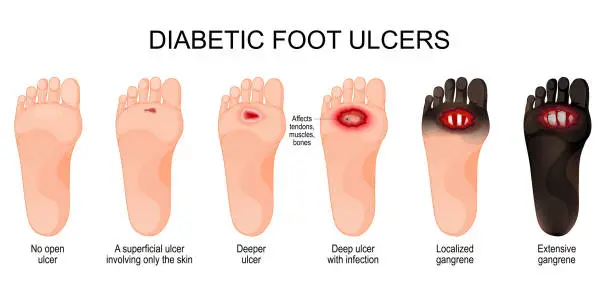- Home
- Robotic Knee Surgery
- General Surgery
- Orthopaedic
- Other Specialities
- About us
- Blogs
- Contact
24 Hours Accident, Trauma & Other Emergency Services . . .
What is the Best Treatment for Diabetic Foot Ulcers?

Diabetic foot ulcers (DFUs) are a common and serious complication of diabetes, affecting millions of people worldwide. If left untreated, these ulcers can lead to severe infections, gangrene, and even amputation. Therefore, seeking the right diabetic foot ulcer treatment is crucial for preventing complications and promoting healing.
At Kapadia Multispeciality Hospital, we specialize in advanced diabetic foot wound treatment and comprehensive diabetic wound care to ensure optimal recovery. In this blog, we’ll explore the best treatment options, preventive measures, and expert care for diabetic foot ulcers.
Understanding Diabetic Foot Ulcers
Diabetic foot ulcers are open sores or wounds that typically develop on the bottom of the foot in people with diabetes. High blood sugar levels can cause nerve damage (neuropathy) and poor blood circulation, making the feet vulnerable to injuries that heal slowly.
Common Causes of Diabetic Foot Ulcers:
- Peripheral neuropathy (loss of sensation in the feet)
- Poor blood circulation (reduced oxygen and nutrient supply to wounds)
- Foot deformities (bunions, hammertoes)
- Uncontrolled blood sugar levels
- Infections due to untreated wounds
Best Treatment for Diabetic Foot Ulcers
Effective diabetic wound treatment requires a multidisciplinary approach. Here are the most recommended treatments:
1. Wound Debridement (Cleaning the Wound)
Debridement involves removing dead or infected tissue to promote healing. Methods include:
- Surgical debridement (performed by a specialist)
- Enzymatic debridement (using medicated ointments)
- Mechanical debridement (wet-to-dry dressings)
2. Infection Control
Since diabetic foot ulcers are prone to infections, antibiotics may be prescribed. Severe infections may require hospitalization and IV antibiotics.
2. Genetics
Keeping pressure off the ulcer is essential for healing. Methods include:
- Specialized footwear
- Custom orthotics
- Crutches or wheelchairs (in severe cases)
4. Advanced Wound Dressings
Modern wound care for diabetic foot ulcers includes:
- Hydrogel dressings (keeps the wound moist)
- Foam dressings (absorbs excess fluid)
- Antimicrobial dressings (prevents infections)
5. Hyperbaric Oxygen Therapy (HBOT)
HBOT increases oxygen supply to the wound, accelerating healing in non-healing ulcers.
6. Vascular Treatment (Improving Blood Flow)
If poor circulation is an issue, procedures like angioplasty or bypass surgery may be needed.
7. Blood Sugar Management
Controlling diabetes is the foundation of diabetic wound treatment. Proper diet, medication, and regular monitoring are essential.
8. Surgical Interventions
In severe cases, surgery may be required to:
- Remove infected bone (osteomyelitis)
- Correct foot deformities
- Perform amputation (last resort)
Why Choose Kapadia Multispeciality Hospital for Diabetic Foot Ulcer Treatment?
At Kapadia Multispeciality Hospital, we offer:
- Expert diabetic foot wound treatment by experienced specialists
- Personalized diabetic wound care plans
- Advanced therapies like HBOT and regenerative medicine
- Multidisciplinary approach (endocrinologists, surgeons, wound care nurses)
- Preventive care and patient education
How to Prevent Diabetic Foot Ulcers
Prevention is always better than cure. Follow these steps to reduce the risk of ulcers:
- Inspect your feet daily for cuts, blisters, or redness
- Keep blood sugar levels under control
- Wear comfortable, well-fitting shoes
- Avoid walking barefoot
- Moisturize feet (but not between toes)
- Schedule regular foot check-ups
Conclusion
Diabetic foot ulcers require prompt and specialized diabetic foot ulcer treatment to prevent complications. With advanced diabetic wound care, proper offloading, infection control, and blood sugar management, healing is possible.
If you or a loved one is suffering from a diabetic foot ulcer, consult the experts at Kapadia Multispeciality Hospital for the best diabetic wound treatment and comprehensive care.
By following the right treatment and preventive measures, diabetic foot ulcers can be managed effectively. For expert care, contact us now.
FREQUENTLY ASKED QUESTIONS
How long does it take for a diabetic foot ulcer to heal?
Healing time varies depending on severity, blood sugar control, and treatment. Minor ulcers may heal in a few weeks, while severe cases can take months.
Can diabetic foot ulcers lead to amputation?
Yes, if left untreated, severe infections or gangrene may require amputation. Early diabetic foot wound treatment reduces this risk.
What is the most effective dressing for diabetic foot ulcers?
Hydrocolloid, hydrogel, and antimicrobial dressings are commonly used. Your doctor will recommend the best option based on the wound condition.
How can I prevent diabetic foot ulcers?
Regular foot inspections, proper footwear, blood sugar control, and professional wound care for diabetic foot ulcers are key preventive measures.
Why is Kapadia Multispeciality Hospital the best for diabetic wound care?
We provide specialized diabetic wound treatment, advanced therapies, and a team of experts to ensure the best outcomes for patients.
